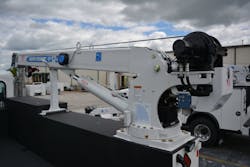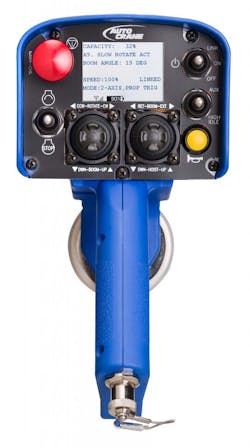Crane Showcases Benefits of Electrohydraulic Controls
At IFPE, Autocrane showcased its service cranes used by field technicians to hoist components into heavy machinery. The crane includes a range of features for the safety of the crane handling of heavy loads.
Electrohydraulic controls enable fine adjustment of fluid flow to separate actuators on the crane. Operators can control the speed and boom angle of the crane using a handheld radio transmitter. The transmitter sends commands to a receiver, which then are translated into electrical pulse-width-modulated (PWM) signals. These signals are sent to the solenoid valves in the valve bank.
The transmitter sends boom angle and load settings to a receiver that translates them into PWM signals for the proportional valves.
The solenoid valves respond to the PWM signals by continually adjusting their spool position. Valve boxes tend to have four or five solenoid valves that divide flow to power separate motors/actuators on the crane. Actuators include a worm gear for rotating the boom and a cylinder for angling it. The fine level of proportional flow through the valves enables precise speed and handling of the load. This allows for proper alignment of components during installation
“Our controls ensure proper control over heavy loads,” says Brian Wutzke, Product Manager at Autocrane. “If a crane is picking up a 7100-lb. engine and aligning it with bolt holes, the field service techs need to make sure it is not swinging wildly.”
Proportional flow also regulates boom cylinder speed as the crane lifts objects off the ground. Valves also respond to readings from pressure and angle sensors on the truck and crane boom. If a loaded boom reaches an angle that could tip the truck, flow will be adjusted to halt the motion of the boom cylinder.
“The innovations we bring lie in safety,” says Wutzke. “With the angle sensing, and so forth, we prevent the truck from tipping over and the operator from doing things that might harm somebody or themselves. There are pressure sensors that will provide feedback if the crane angle is in danger of tipping the truck.”
The crane includes other standard features, like a counter balance valve to prevent run-away by a heavy load. A PTO and pump on the bottom of the truck take excess energy from the transmission and feed it to an air pump to power end tools on the boom.
About the Author
Leah Scully
Associate Content Producer
Leah Scully is a graduate of The College of New Jersey. She has a BS degree in Biomedical Engineering with a mechanical specialization. Leah is responsible for Hydraulics & Pneumatics’ news items and product galleries.

Leaders relevant to this article:


